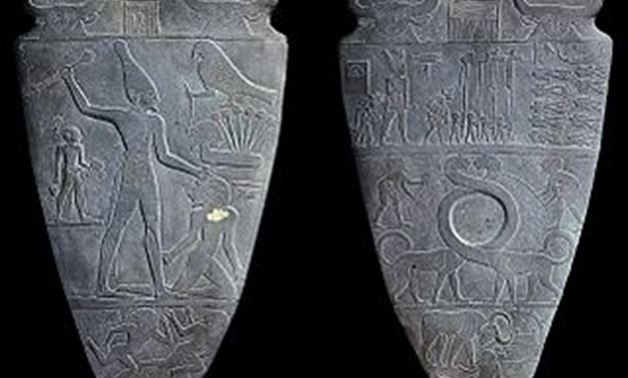https://www.egypttoday.com/Article/4/40388/Top-facts-about-man-who-unified-Egypt

Fragmented from Narmer Palette – Photo Courtesy of Wikipedia
Top facts about man who unified Egypt
CAIRO - 18 January 2018: The man who unified Egypt, a common sentence that most Egyptian people hear and knew through school books like "Menes: The Unifier of Upper and Lower Egypt" or even through a number of songs such as Mohamed Mounir's "Etkalemy" (Speak Up).
Although the fact of Narmer/Menes is completely true in the commoners' point of view, it is problematic to Egyptologists. For example, archaeologist and author Joshua J. Mark of Ancient History Encyclopedia explained, "Menes unified the country through conquest. In the early days of Egyptology, these kings were considered to be two different men. Narmer was thought to have attempted unification at the end of one period and Menes to have succeeded him, beginning the next era in Egyptian history."
Meanwhile, the great Egyptologist Flinders Petrie claimed Narmer and Menes were two names designating one man: Narmer was his name and Menes an honorific. Petrie claimed that he was the first pharaoh of the First Dynasty.
So, the first fact about Menes is that he is the founder of the First Dynasty after he unified Egypt in 3200 B.C., according to Manetho.
He constructed the first unified capital for Egypt called Memphis. Furthermore, he surrounded it with a white wall, according to researcher and author Hussein Abdel Bassir.
Menes not only unified the lands of Egypt, but he also unified the official religion, making Horus the god of Egypt, according to private newspaper El Fagr's historical series.
Abdel Bassir also added that Menes enhanced the economic and military presence of Egypt in the lands of Canaan.
A number of late discoveries expressed that Canaan was a part of the Egyptian kingdom, not just an economic partner.
In 1994, a number of Israeli archaeological missions unearthed many artifacts that dated back to the Egyptian pre-dynastic era, in addition to Menes' reign, El Fagr's historical series stated.
In 1988, one of the greatest archaeological discoveries was found by British archaeologists James E. Quibell and Frederick W. Green in the Temple of Horus at Nekhen, which is the Narmer Palette
The Narmer Palette indicated huge information about Lower and Upper Egypt's gods such as Hathor and Horus.
Also, the palette shows Menes' military victories while unifying Egypt, and it portrayed Narmer while wearing the unified crown of Egypt with two colors.
-- Sent from my Linux system.
No comments:
Post a Comment